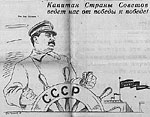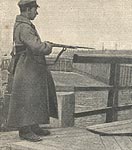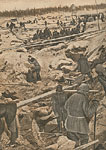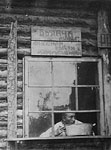Belomorkanal
On 2 August 1933, the 'White Sea-Baltic Canal in the name of Stalin' was officially opened. In Russian the canal is called the Belomorsko-baltiysky kanal, or shortened to 'Belomorkanal'. It is a vital link between St. Petersburg (Leningrad) and the White Sea, constructed between 1930 and 1933, mostly by penal labor.
Possibly 150.000 convicts* worked on the project, digging 37 km. of the canal through hard rock and building 19 large wooden locks, with little mechanical equipment. They were 'enemies of the people' - farmers, political prisoners and criminals - and lived in guarded camps. The hard labor was officially meant to 'reforge' them, to make new men of them who would be good Soviet citizens. In reality, their life was cheap. Tens of thousands of convicts died under the harsh conditions.
Pravda and Izvestija
 |
 |
'The captain of the country of the Soviets' |
Stalin, Voroshilov and Kirov |
The opening of the canal, a showpiece in the Soviet Union's first Five Year Plan, was accompanied by a huge propaganda campaign. Newspapers such as Pravda and Izvestija published articles, propaganda cartoons and portraits of 'reforged' workers.
 |
 |
 |
 |
P.F. Bisse: |
A.I. Kochegarov: |
K. Gumarov: |
B.V. Ginzburg: |
Memorial Book
 'Labour re-educates them' |
 'Electricity wires on the crosses of old Karelia' |
 'They do not hold the rifle like this to frighten' |
A group of 120 writers and artists was sent to the canal to produce a memorial book eulogizing the efforts. It was published in 1934, edited by Maksim Gorki and features articles by well-known writers such as Aleksei Tolstoy, Boris Pilniak, Ilf and Petrov, Viktor Shklovsky and Mikhail Zoshchenko, as well as photographs by Aleksandr Rodchenko.
The pictures are heavily retouched. Many of them have dynamic compositions and are accompanied by flowery captions.
 'We study nature and obtain freedom' |
 'By changing nature, man changes himself' |
 'Last hours on the lock' |
Documentary Photographs
 Documentary photographs in the Karelian State Regional Museum in Petrozavodsk provide a more realistic image. The harsh environment, primitive working conditions and lack of mechanical equipment are visible. But even here, the true horrors of the project are not shown.
Documentary photographs in the Karelian State Regional Museum in Petrozavodsk provide a more realistic image. The harsh environment, primitive working conditions and lack of mechanical equipment are visible. But even here, the true horrors of the project are not shown.
 |
 |
 |
 |
 |
 |
 |
 |
 |
Postscript
Most of the convicts who survived the Belomorkanal were sent to other penal labor projects, such as the the Moscow-Volga canal. Apparently their re-education through labour had not yet finished. The Belomorkanal is still in use. But one of the main reasons it is still fairly well-known today is that there is a popular brand of strong, inexpensive Russian cigarettes with the same name.
Besides the pictures, you can find here a longer text in Dutch on the backgrounds of the Belomorkanal and a list of source material related to the Belomorkanal and the GULAG in the collections of the IISH.
Thanks to:
Bastiaan Kwast, Delft
Iurii Dmitriev, Petrozavodsk
Karel'skii gos. kraevedcheskii muzei (Karelian State Regional Museum), Petrozavodsk
*)
The number of convicts is estimated between 128.000 and 180.000. Some believe that 100,000 died on the project.


